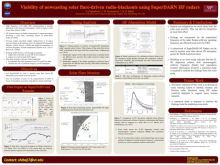Viability of nowcasting solar flare-driven radio-blackouts using SuperDARN HF radars
Shibaji
Chakraborty
Virginia Tech
Poster
The first space weather impact of a solar flare is radio blackout across the dayside of the Earth. At a delay of just 8 minutes, the arrival of enhanced X-ray and EUV radiation leads to a dramatic increase in ionization density in the lower ionosphere. Operation of HF systems are often completely suppressed due to anomalous absorption, while many RF systems suffer some degradation. While the onset of blackout is very rapid (∼ 1-minute), the recovery takes tens of minutes to hours [3]. Furthermore, severe solar flares can disrupt emergency HF communications that support humanitarian aid services, including amateur radio and satellite communication systems. Our current monitoring capability is based on modeling the ionospheric impacts based on GOES satellite observations of solar fluxes. We present a technique to characterize radio blackout following solar flares using HF radar. The future extension of this work is to develop an now-casting system to identify and monitor radio blackouts using HF radars currently deployed to support space science research. Networks of such radars operate
continuously in the northern and southern hemisphere as part of the SuperDARN collaboration. Recent studies have shown that radio blackout (also known as shortwave fadeout) is easily detected and characterized using radar observations. We will combine real-time observations from the North American suite of SuperDARN radars to specify the occurrence of radio blackouts in near real-time.
continuously in the northern and southern hemisphere as part of the SuperDARN collaboration. Recent studies have shown that radio blackout (also known as shortwave fadeout) is easily detected and characterized using radar observations. We will combine real-time observations from the North American suite of SuperDARN radars to specify the occurrence of radio blackouts in near real-time.

Poster PDF
Poster category
Ionosphere and Thermosphere Research and Applications
Meeting homepage